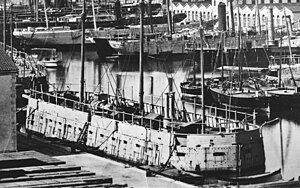 Lave, one of the Aetna class's French half-sisters.
| |
| Class overview | |
|---|---|
| Name | Aetna class |
| Operators | |
| Succeeded by | Erebus class |
| Built | 1854–1856 |
| In service | 1855–1873 |
| Planned | 5 |
| Building | 6 |
| Completed | 5 |
| Lost | 2 |
| Retired | 4 |
| General characteristics | |
| Type | Ironclad floating battery |
| Tons burthen |
|
| Length |
|
| Beam |
|
| Draught |
|
| Propulsion | |
| Sail plan | 3 masts, 885 m2 (9,530 sq ft) sail[3] |
| Speed | |
| Complement | 200[1] |
| Armament |
|
| Armour | |

The Aetna-class ironclad floating batteries were built during the Crimean War for the attack of Russian coastal fortifications.
Britain and France each laid down five of these coastal attack vessels in 1854. The French used three of their batteries in 1855 against the defences at Kinburn on the Black Sea, where they were effective against Russian shore defences. The British plan to use theirs in the Baltic Sea against Kronstadt in 1856 was influential in causing the Russians to sue for peace.[4] The development of such iron-armoured batteries was a step towards the development of ironclad warships. "These armoured batteries were among the most revolutionary ships ever built and provided British and French designers with the germ of the battleship."[2]
One of the British batteries, Trusty, was used for trials in 1861 with a prototype rotating turret, based on Captain Cowper Phipps Coles' designs.
- ^ a b c d e f g h i j Cite error: The named reference
LyonWinfieldwas invoked but never defined (see the help page). - ^ a b c Cite error: The named reference
Brown156was invoked but never defined (see the help page). - ^ Brown, David K Before the Ironclad, development of ship design, propulsion and armament in the Royal Navy, 1815–60, pub Conway, 1990, ISBN 0-85177-532-2 page 5 has a drawing of Thunderer at sea with three masts and sails.
- ^ Lambert A. "Iron Hulls and Armour Plate"; Gardiner Steam, Steel and Shellfire p. 47-55